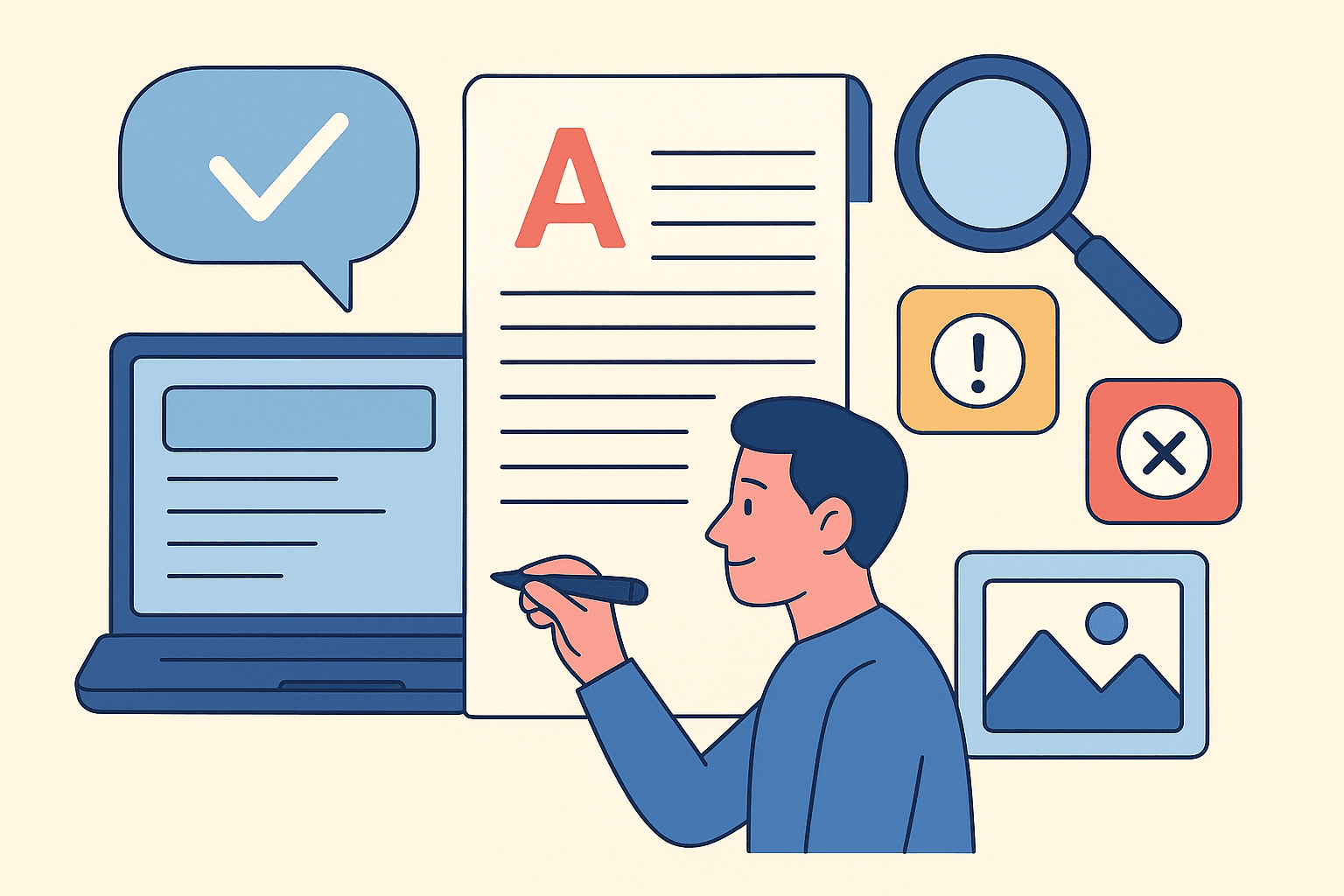Beginner writers often make the mistake of focusing on writing tools. Writing tools are secondary to the writing skill itself. If you want to learn to become a better writer, use the free writing tools available online.
Table of Contents
Essential Skills for Technical Writers
Technical writing is a specialized field that demands a unique set of skills to effectively communicate complex information. Clarity and conciseness stand at the forefront of these skills. A proficient technical writer must straightforwardly convey information, eliminating ambiguity to enhance comprehension among diverse audiences. By utilizing tools such as Hemingway Editor or Grammarly, writers can refine their content, ensuring it remains clear and devoid of unnecessary jargon or filler. These tools provide real-time feedback, allowing writers to focus on readability and grammatical accuracy.
Understanding the audience is another critical skill. A technical writer must tailor their language, tone, and content complexity to align with the knowledge level and expectations of the target audience. Resources like user personas and audience analysis templates can facilitate this understanding, guiding writers in crafting content that resonates with readers. Free tools such as Google Forms can be employed to gather feedback from potential users, ensuring the material being created meets their needs and preferences.
Research skills also play an essential role in technical writing. Writers must have the ability to gather accurate information from credible sources, synthesize that data, and communicate it effectively. Utilizing online databases, academic journals, and industry-specific websites can enhance the quality of research. Tools such as Zotero assist in managing citations and references, making it easier to maintain accuracy and credibility in writing.
Lastly, the ability to simplify complex information is paramount. This skill enables writers to break down intricate concepts into digestible components, ensuring accessibility for a broader audience. Visualization tools like draw.io can aid in creating diagrams and infographics, translating complex ideas into visual representations that enhance understanding. Together, these skills are vital for any aspiring technical writer, and leveraging free tools can significantly bolster one’s ability to excel in this field.

Should you purchase licenses or use free writing tools?
Using free writing tools is a good way to get started. It’s easier to find learning resources for free writing tools. Some free writing tools, like those listed in this article, also have an active community to help you learn them. Your first focus as an aspiring writer should be to hone your writing skills, and the free writing tools here will help you do exactly that. All the free writing tools here also have paid versions that offer more functionality. So, if you need to tap into those premium features in the future, you can always upgrade your membership.
Top Free Writing Tools for Enhancing Technical Writing Skills
In the realm of technical writing, utilizing the right tools is essential for professionals seeking to elevate their craft. Numerous free writing tools are available to assist budding technical writers in honing their skills, formatting documentation, and generating content efficiently. Here, we outline a selection of notable tools, each serving distinct functions to aid in the development of technical writing competencies.
Grammarly is a well-known proofreading tool that helps writers eliminate grammatical errors and enhance overall clarity in their documents. By providing real-time feedback on sentence structure, punctuation, word choice, and even style suggestions, Grammarly assists technical writers in producing polished and professional content. This free writing tool integrates seamlessly into various platforms, making it accessible for everyday writing tasks.
Google Docs is an invaluable collaborative free writing tool that supports real-time co-authoring and editing. This cloud-based application enables technical writers to collaborate with team members and stakeholders effectively. Its built-in templates and formatting options facilitate the creation of structured documents, while the version history feature ensures that previous iterations are easily accessible for review.
Canva is perhaps one of the best image editors available if you are working on multiple outputs. This cloud-based application enables technical writers to edit screenshots and create presentations, posters, infographics, and so on. This tool is a favorite of designers and marketers.
Markdown Editors, such as Dillinger or StackEdit, provide a streamlined writing experience that emphasizes simplicity and speed. These free writing tools are essentially editors that allow technical writers to create formatted content using a straightforward syntax. This makes it easy to produce README files, documentation, or online articles. The straightforward nature of Markdown ensures that writers can focus on content creation without getting bogged down by complex formatting tools.
Hemingway Editor serves as a valuable resource for improving readability in technical writing. This tool assesses text complexity and highlights areas where simplification is necessary. By promoting concise writing and minimizing passive voice usage, Hemingway Editor aids writers in crafting clear and effective documentation that resonates with a wide audience.
By leveraging these free tools, technical writers can refine their skills, streamline their workflow, and create content that is not only informative but also engaging for the target audience. These applications each provide unique functions that collectively contribute to the development of proficient technical writing abilities.
Tool 1: Grammarly – Perfecting Your Grammar and Style
Grammarly is a widely recognized tool that serves to enhance the quality of technical writing by providing comprehensive grammar and style assistance. Its accessibility makes it suitable for writers at various levels, from novices to experienced professionals. This free writing tool’s platform primarily focuses on correcting grammatical errors, suggesting style improvements, and ensuring clarity in composition, which are essential elements in effective technical writing.

For beginners, Grammarly offers a user-friendly interface with fundamental features that efficiently identify basic grammatical mistakes, such as subject-verb agreement and punctuation errors. This real-time feedback allows novice writers to understand common pitfalls in grammar, enabling them to learn and improve continuously. Furthermore, the platform’s clarity suggestions assist in refining sentence structure, promoting more straightforward and concise writing, which is crucial for technical documents that aim to convey complex information clearly.
Mid-level writers can take advantage of Grammarly’s advanced features that provide deeper insights into their writing. Options such as the tone detector, readability score, and genre-specific writing style checks empower users to tailor their content to specific audiences. This is particularly valuable in technical writing where precision and appropriate style are necessary to meet industry standards. The ability to set language preferences also ensures that writers can maintain consistency throughout their documents.
Moreover, Grammarly’s integration with various writing platforms, including Google Docs and Microsoft Word, enhances convenience, allowing writers to benefit from its features anywhere they compose text. The seamless blend of basic and advanced functionalities makes Grammarly a versatile tool, catering to the needs of both beginners and seasoned writers striving to elevate the quality of their technical writing.
Tool 2: Hemingway App – Simplifying Your Writing
The Hemingway App is a powerful tool that aids technical writers in enhancing the clarity and readability of their documents. By analyzing text, this app identifies complex sentences and offers suggestions to improve overall readability. Its primary function is to simplify writing by making it more straightforward and accessible to a broad audience, which is crucial for anyone engaged in technical communication.

One of the standout features of the Hemingway App is its ability to highlight sentences deemed overly complex or difficult to understand. Writers can easily spot passages that may need revision, allowing them to break these sentences into simpler components. This free writing tool not only aids in crafting clear and concise documents but also ensures that the intended message resonates with the audience. In technical writing, where precision is paramount, the app’s suggestions can serve as a valuable guide to achieving better comprehension.
The app also utilizes a grading system to evaluate text, assigning it a reading level that corresponds to the target audience. This feature enables writers to align their content with the appropriate comprehension level of their readers. By integrating this aspect into their writing workflow, technical writers can effectively tailor their documents to meet the expectations and capabilities of their audience.
Furthermore, the Hemingway App encourages users to maintain an active voice and eliminate unnecessary adverbs, which can clutter writing and obscure the main points. By promoting such principles, technical writers are better equipped to produce clearer, more engaging documentation. Overall, incorporating the Hemingway App into one’s writing process can significantly elevate the quality of technical documents, ultimately making them more effective in conveying essential information.
Tool 3: Google Docs – Collaborative Writing Made Easy
Google Docs is a powerful online word-processing tool that has become an essential resource for collaborative technical writing. It is one of my favorite free writing tools. Its primary appeal lies in its real-time collaboration capabilities, allowing multiple users to work on a document simultaneously. This feature is particularly beneficial for technical writing teams that require immediate feedback and input from various team members. With Google Docs, writers can see changes as they happen, which fosters effective communication and enhances the overall productivity of the team.

One of the standout features of Google Docs is its commenting system. Users can leave comments on specific portions of the text, facilitating focused discussions around particular sections of technical documentation. This capability empowers writers to clarify complex information and engage in constructive feedback loops, crucial for producing high-quality content. Furthermore, team members can respond directly to comments, ensuring that discussions remain streamlined and organized. This interactive feature is paramount for technical writing, as it aids in refining ideas and improving the clarity of the document.
Moreover, Google Docs offers robust document management solutions. Users can easily share documents with team members or external reviewers, adjusting permissions to control who can view or edit the document. This flexibility is vital for managing drafts and revisions effectively, especially in large projects where many contributors are involved. The version history feature allows users to track changes over time, ensuring that all contributions are preserved and accessible. This insight enables teams to maintain a cohesive writing process, reducing potential miscommunication and enhancing overall efficiency in technical writing projects.
In its entirety, Google Docs serves as an indispensable tool for collaborative technical writing. Its real-time editing, commenting capabilities, and effective document management improve the writing experience, making it a favored choice among writers seeking to streamline their collaborative workflows.
Tool 4: Canva – Visual Communication in Technical Writing
In the realm of technical writing, clarity and engagement are paramount. One of the ways to achieve this is through effective visual communication, and Canva has emerged as an invaluable tool in this regard. Designed with user-friendliness in mind, Canva allows technical writers to create aesthetically pleasing visuals such as diagrams, infographics, and presentations, all of which significantly enhance the comprehension of technical content.

Diagrams serve as an excellent means to break down complex concepts, enabling readers to visualize relationships and processes more abstractly. With Canva’s extensive library of templates and customizable elements, writers can easily construct diagrams that are not only functional but also visually appealing. This can be particularly beneficial when explaining intricate systems or workflows, where a well-designed diagram can replace pages of text and provide immediate clarity.
Additionally, infographics have become an effective medium to convey large amounts of data succinctly. As readers increasingly prefer visual information, the ability to summarize key points and illustrate statistics through engaging graphics can significantly improve the retention of information. Canva provides a vast array of icons, charts, and design elements that can help technical writers create compelling infographics, effectively marrying data with design to foster better understanding.
Moreover, the option to create presentations within Canva allows technical writers to share their work in a streamlined format, catering to various audiences, whether in academic settings or corporate environments. A well-structured presentation can effectively summarize complex topics and engage viewers, making it easier for them to absorb and apply the information presented. Use Canva to process (and edit images) and any of the above free writing tools to create wonderful documentation and improve your writing.
In conclusion, the integration of visuals through tools like Canva not only complements traditional technical writing but transforms it into a more engaging and comprehensible experience. By leveraging Canva’s capabilities, technical writers can unlock the potential of visual communication, enhancing both the quality of their content and the reader’s understanding.
Conclusion
As we conclude our exploration of free tools that can enhance technical writing skills, it is essential to acknowledge the significance of continuous learning in this field. The resources discussed provide invaluable support for both beginners and mid-level technical writers, enabling them to refine their abilities and adapt to the ever-evolving demands of the industry. These tools serve as foundations that can boost knowledge, improve writing quality, and streamline the technical documentation process.
The pursuit of expertise in technical writing is not a destination but rather an ongoing journey. The ever-changing nature of technology necessitates that writers remain up-to-date with the latest methodologies and tools available. By leveraging these free resources, individuals can cultivate a deeper understanding of technical concepts while enhancing their ability to communicate complex information clearly and efficiently.
In addition to the specific tools highlighted, technical writers must engage in various learning opportunities such as workshops, webinars, and professional communities. These experiences can foster collaboration, providing insights that are often not found in traditional training methods. Joining professional networks can also facilitate knowledge sharing with peers, further enriching the learning process.
Ultimately, embracing a mindset geared towards continuous learning is vital for success in technical writing. The tools and resources discussed are just starting points, and it is through the exploration and utilization of these options that writers can unlock their full potential. As you continue your journey in technical writing, may you find inspiration and growth through these invaluable free resources, and may they propel your skills to new heights.
I have covered more free writing tools in another article that you can check out here.
I hope you found this article helpful. If you didn’t, then I would love to hear from you about what I can do to improve it. For more technical writing-related articles and resources, see the Technical Writing page. Also consider following my YouTube channel learntechnicalwriting, Reddit community r/learntechnicalwriting and Quora space Technical Writer | Technical Writing for more such content.


